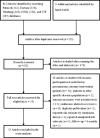Prognostic value of red cell distribution width in patients undergoing percutaneous coronary intervention: a meta-analysis
- PMID: 32912972
- PMCID: PMC7485231
- DOI: 10.1136/bmjopen-2019-033378
Prognostic value of red cell distribution width in patients undergoing percutaneous coronary intervention: a meta-analysis
Abstract
Objective: To evaluate the prognostic value of baseline red cell distribution width (RDW) in patients with coronary artery diseases (CADs) undergoing percutaneous coronary intervention (PCI) by conducting a meta-analysis.
Design: Systematic review and meta-analysis.
Data source: PubMed, Embase, Wanfang, CNKI and VIP databases were searched from their inceptions to 19 June 2019.
Eligible criteria: Studies investigating the value of baseline RDW for predicting all-cause mortality, cardiovascular mortality and major adverse cardiac events (MACEs) in patients with CAD undergoing PCI were included.
Data extraction and synthesis: Two authors independently extracted the data and evaluated the methodological quality using the Newcastle-Ottawa Scale. STATA V.12.0 software was applied to produce the forest plots using a random-effect model.
Results: Twelve studies (13 articles) involving 17 113 patients were included and analysed. Comparison between the highest and lowest RDW category indicated that the pooled risk ratio (RR) was 1.77 (95% CI 1.32 to 2.37) for all-cause mortality, 1.70 (95% CI 1.25 to 2.32) for cardiovascular mortality and 1.62 (95% CI 1.21 to 2.18) for MACEs. The predictive effect of elevated RDW for all-cause mortality was stronger in the subgroup of patients without anaemia (RR 4.59; 95% CI 3.07 to 6.86) than with anaemia.
Conclusions: This meta-analysis indicated that elevated RDW was associated with higher risk of mortality and adverse cardiac events in patients with CAD undergoing PCI. The value of elevated RDW for predicting all-cause mortality appears to be stronger in patients without anaemia. RDW may be served as a promising prognostic biomarker in patients undergoing PCI.
Keywords: all-cause mortality; major adverse cardiac events; meta-analysis; percutaneous coronary intervention; red cell distribution width.
© Author(s) (or their employer(s)) 2020. Re-use permitted under CC BY-NC. No commercial re-use. See rights and permissions. Published by BMJ.
Conflict of interest statement
Competing interests: None declared.
Figures




Similar articles
-
Prognostic Impact of Red Cell Distribution Width on the Development of Contrast-Induced Nephropathy, Major Adverse Cardiac Events, and Mortality in Coronary Artery Disease Patients Undergoing Percutaneous Coronary Intervention.Curr Cardiol Rev. 2021;17(6):e051121191160. doi: 10.2174/1573403X17666210204154812. Curr Cardiol Rev. 2021. PMID: 33563170 Free PMC article.
-
Combined Value of Red Blood Cell Distribution Width and Global Registry of Acute Coronary Events Risk Score for Predicting Cardiovascular Events in Patients with Acute Coronary Syndrome Undergoing Percutaneous Coronary Intervention.PLoS One. 2015 Oct 15;10(10):e0140532. doi: 10.1371/journal.pone.0140532. eCollection 2015. PLoS One. 2015. PMID: 26468876 Free PMC article.
-
The Combination Effect of the Red Blood Cell Distribution Width and Prognostic Nutrition Index on the Prognosis in Patients Undergoing PCI.Nutrients. 2024 Sep 19;16(18):3176. doi: 10.3390/nu16183176. Nutrients. 2024. PMID: 39339776 Free PMC article.
-
Prognostic role of red blood cell distribution width in patients with sepsis: a systematic review and meta-analysis.BMC Immunol. 2020 Jul 6;21(1):40. doi: 10.1186/s12865-020-00369-6. BMC Immunol. 2020. PMID: 32631218 Free PMC article.
-
Contrast-induced acute kidney injury and adverse clinical outcomes risk in acute coronary syndrome patients undergoing percutaneous coronary intervention: a meta-analysis.BMC Nephrol. 2018 Dec 22;19(1):374. doi: 10.1186/s12882-018-1161-5. BMC Nephrol. 2018. PMID: 30577763 Free PMC article.
Cited by
-
The red blood cell distribution width is associated with all-cause and cardiovascular mortality among individuals with non-alcoholic fatty liver disease.PLoS One. 2025 Apr 17;20(4):e0321789. doi: 10.1371/journal.pone.0321789. eCollection 2025. PLoS One. 2025. PMID: 40245046 Free PMC article.
-
Red Cell Distribution Width and Mortality in Patients Undergoing Percutaneous Coronary Intervention.Biomedicines. 2021 Dec 26;10(1):45. doi: 10.3390/biomedicines10010045. Biomedicines. 2021. PMID: 35052725 Free PMC article.
-
Prognostic Impact of Red Cell Distribution Width on the Development of Contrast-Induced Nephropathy, Major Adverse Cardiac Events, and Mortality in Coronary Artery Disease Patients Undergoing Percutaneous Coronary Intervention.Curr Cardiol Rev. 2021;17(6):e051121191160. doi: 10.2174/1573403X17666210204154812. Curr Cardiol Rev. 2021. PMID: 33563170 Free PMC article.
-
Red Cell Distribution Width and Patient Outcome in Cardiovascular Disease: A ''Real-World'' Analysis.J Cardiovasc Dev Dis. 2021 Sep 26;8(10):120. doi: 10.3390/jcdd8100120. J Cardiovasc Dev Dis. 2021. PMID: 34677189 Free PMC article.
-
Impact of nutritional index on contrast-associated acute kidney injury and mortality after percutaneous coronary intervention.Sci Rep. 2021 Mar 29;11(1):7123. doi: 10.1038/s41598-021-86680-7. Sci Rep. 2021. PMID: 33782522 Free PMC article.
References
Publication types
MeSH terms
LinkOut - more resources
Full Text Sources
Miscellaneous
